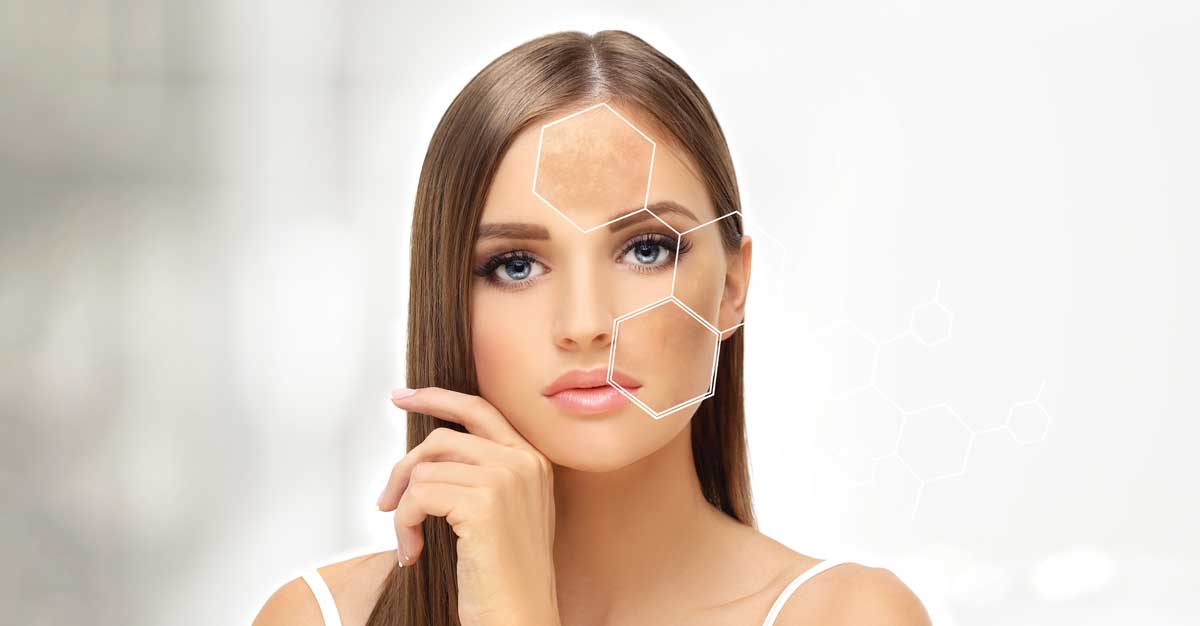23 Apr Melasma, Spots & Scars: The New Tech in Pigmentation Treatment

In a world where flawless skin is more than just a beauty goal, it’s a confidence booster. pigmentation concerns like melasma, dark spots, and acne scars remain among the most persistent and frustrating. But today, science is catching up with our skincare aspirations. Thanks to revolutionary ingredients and advanced technologies, the path to even-toned, radiant skin has never been more promising.
The New Era of Pigmentation Treatment
Pigmentation disorders often have complex causes, ranging from sun exposure and hormonal imbalances to inflammation and genetics. Traditional treatments such as hydroquinone and chemical peels have long been used, but new innovations are rewriting the rules.
Here’s what’s making waves in the fight against stubborn spots:
1. MelaSyl: The Ingredient Everyone’s Talking About
 One of the most exciting recent breakthroughs is MelaSyl, a patented molecule developed to target melanin production at the source. Unlike traditional lightening agents that can irritate or sensitize the skin, MelaSyl offers a gentle yet highly effective solution, especially for individuals with sensitive skin or chronic hyperpigmentation issues like melasma.
One of the most exciting recent breakthroughs is MelaSyl, a patented molecule developed to target melanin production at the source. Unlike traditional lightening agents that can irritate or sensitize the skin, MelaSyl offers a gentle yet highly effective solution, especially for individuals with sensitive skin or chronic hyperpigmentation issues like melasma.
 Why it works: MelaSyl interrupts the melanogenesis process, reducing the formation of new pigmentation without disrupting the skin barrier. It’s being incorporated into premium skincare formulations and is already showing impressive clinical results.
Why it works: MelaSyl interrupts the melanogenesis process, reducing the formation of new pigmentation without disrupting the skin barrier. It’s being incorporated into premium skincare formulations and is already showing impressive clinical results.
2. Laser Treatments: More Precise, Less Downtime
 Laser technologies have evolved significantly, offering tailored energy levels and skin-specific wavelengths to treat pigmentation without causing collateral damage. Devices like picosecond lasers, fractional lasers, and intense pulsed light (IPL) target melanin clusters with high precision.
Laser technologies have evolved significantly, offering tailored energy levels and skin-specific wavelengths to treat pigmentation without causing collateral damage. Devices like picosecond lasers, fractional lasers, and intense pulsed light (IPL) target melanin clusters with high precision.
 What’s new: Many of today’s devices combine cooling systems, customizable settings, and shorter pulse durations, making treatments safer, more comfortable, and effective even on darker skin tones.
What’s new: Many of today’s devices combine cooling systems, customizable settings, and shorter pulse durations, making treatments safer, more comfortable, and effective even on darker skin tones.
3. Regenerative Serums and Post-Laser Boosters
 Following in-office treatments, skin regeneration plays a key role in long-term results. New-generation serums packed with growth factors, niacinamide, tranexamic acid, and vitamin C are now being used post-procedure to boost healing, reduce inflammation, and prevent pigment rebound.
Following in-office treatments, skin regeneration plays a key role in long-term results. New-generation serums packed with growth factors, niacinamide, tranexamic acid, and vitamin C are now being used post-procedure to boost healing, reduce inflammation, and prevent pigment rebound.
 Pro tip: Consistency in post-treatment skincare is just as important as the in-clinic procedures themselves. Professional-grade formulations are your best ally here.
Pro tip: Consistency in post-treatment skincare is just as important as the in-clinic procedures themselves. Professional-grade formulations are your best ally here.
4. Smart Skincare Regimens Powered by AI
 AI-driven diagnostics and smart skincare systems are enabling hyper-personalized solutions. By analyzing skin condition, lifestyle, and even climate, these systems recommend the most effective treatments and active ingredients tailored to each individual’s skin journey.
AI-driven diagnostics and smart skincare systems are enabling hyper-personalized solutions. By analyzing skin condition, lifestyle, and even climate, these systems recommend the most effective treatments and active ingredients tailored to each individual’s skin journey.
 Takeaway: Pigmentation care is no longer one-size-fits-all. It’s dynamic, data-driven, and deeply personal.
Takeaway: Pigmentation care is no longer one-size-fits-all. It’s dynamic, data-driven, and deeply personal.
Hope for Every Skin Tone
With rising awareness, better formulations, and safer technology, patients of all skin tones can now seek targeted pigmentation treatments without fear of side effects or worsening symptoms. Whether you’re dealing with hormonal melasma, sun-induced dark spots, or post-acne marks, there’s a new era of options and real hope on the horizon.













